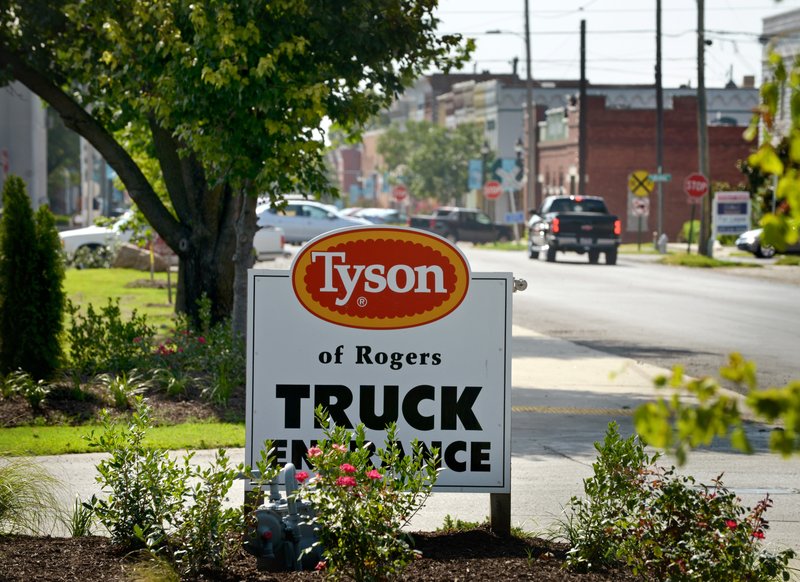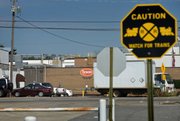ROGERS -- Workers at a Tyson Foods deboning plant suited up in hairnets, gloves and robes Friday as people across the railroad tracks from the plant bustled into shops and restaurants on First Street in downtown Rogers.
As the downtown area shifts into a new age with a recently approved master plan, city officials have said industrial plants will continue to play a vital role.
Mayor Greg Hines said industrial plants bring jobs to Rogers and downtown.
"I think it is important to have a city with a diverse workforce," Hines said. "The way to ensure long-term success is to have a broad spectrum, the right mix of job creators."
Companies with industrial plants downtown include Tyson Foods and Pel-Freez.
Tyson employs 450 workers at the downtown Rogers plant, according to a fact sheet the company provided, generating an annual payroll of $11.5 million. Tyson has owned the plant since 1963.
Manuel Resendez, general production manager for the downtown plant, said about 80 percent of the employees, or 360, live in Rogers. About 25 percent, or 90, live downtown, he said.
Pel-Freez opened its plant in downtown Rogers in the 1950s, said Regina Stowe, the company's foods division manager. The company processes rabbit meat along with raw materials for biological research and diagnostic manufacturing, she said. It employs 48 people.
Industry history
Industrial and manufacturing plants always have been a part of downtown Rogers, said Raymond Burns, CEO Rogers-Lowell Chamber of Commerce. The chicken industry, in particular, is a part of Rogers history, he said.
The Rogers location was Tyson's first acquisition, said Jeffrey Woods, Tyson director of community relations. It previously was owned by Garrett Poultry Company, which opened in Rogers during the 1930s.
"The entire Rogers airport was designed to fly baby chicks in and out," Burns said.
The function of the Tyson plant downtown has changed throughout the years, said Derek Baucom, Tyson vice president of operations. It has been a deboning factory since about the 1970s, he said. It once boiled the meat to remove the bones but in recent years switched to manual removal.
Workers remove skin and bones from 11,000 to 12,000 pounds of chicken an hour at the plant with the use of a conveyor belt, Resendez said.
Concerns raised
Some Rogers landowners raised concerns about the Tyson plant during the downtown master plan approval process. Comments about bad smells and the building being an eyesore were a few complaints during public meetings.
McKenzie Shetrone walked around downtown with a friend Friday. Shetrone moved into a house near the plant in the past year, she said.
"It smells sometimes," Shetrone said. "I also wish trucks would not turn down my street."
Shetrone said she can smell bad odors coming from the plant only sometimes when the wind shifts or it is hot outside.
"I don't mind the plant," Shetrone said. "I just wish it didn't smell."
The plant is well landscaped, Shetrone said. She said she also prefers using the sidewalk in front of the plant because it is nicer than other sidewalks in the area.
About $4 million in improvements and upgrades have been invested at the plant, said Derek Burelson, Tyson corporate affairs officer. This includes paving a parking lot, installing sidewalks, extending a fence, painting the exterior and adding landscaping.
"The plant has had some odor problems in the past," Burelson said. "But because of operational changes and improvements, we haven't received any odor complaints in years."
Tyson has been quick to respond to complaints in the past, Burns said.
"They recognize that they are in a downtown area," Burns said. "They have really gone above and beyond what they needed to do, even changing their facility. I think they should be commended for it."
Zach McDaniel works downtown and grew up in Rogers. He said the Tyson plant is positive for the region.
"It brings a lot of jobs to the area," McDaniel said. He also said he remembers Tyson donating to school functions and fundraisers he has been a part of throughout the years.
Woods said Tyson works to support the area. It provides translators to local schools for parent-teacher conferences and supports local events downtown such as Frisco Fest. It also donates to charities such as United Way of Northwest Arkansas, the annual NW Arkansas Heart Walk and the Cancer Society Relay for Life. Food donations also are given to local charities, he said.
Zoning shifts
Zoning changes that are part of the downtown master plan, approved by the City Council last month, call for an industrial arts district downtown. However, several existing plants such as Tyson and Pel-Freez have been re-zoned under new designations that no longer allow industrial business when they redevelop.
Scott Polikov, founder of Gateway Planning, said industries such as Tyson Foods serve as an employment center and economic activity creator for downtown Rogers. Gateway Planning was contracted by the city to design the downtown master plan.
"Tyson has assured us they will always work with the community to respond to concerns about plant impacts on the community in terms of noise, odors and managing truck traffic," Polikov said.
The master plan does, however, show how the Tyson plant could be redeveloped in the future, Polikov said. If Tyson decided to relocate, the site could extend development similar to what is found on First Street in downtown, he said.
The site where the Tyson plant sits is zoned core mixed-use in the new downtown plan. The zoning requirement allows for business and residential uses similar to what is found across the tracks on First Street.
A portion of the Pel-Freez land has been re-zoned for "industrial-arts" use, while another portion is now rezoned "transition." The downtown plan gives an example of how single-family homes could be built on the Pel-Freez site in the future.
Polikov previously has said conversations with Pel-Freez suggested the company plans to move its facility in the near future. Representatives with Pel-Freez declined to comment.
A lawyer representing Pel-Freez sent a letter to City Council members on July 27 stating the company's plans to ask for a rezoning of the land. The letter states the transition zoning doesn't allow for industrial use.
"Pel-Freez prefers that all of its property be in the IA zone where it's a permitted use," says the email from George Rhoads of the Matthews, Campbell, Rhoads, McClure and Thompson law firm.
Existing properties are grandfathered in with the zoning changes, Polikov said. The new zoning laws would only be enforced if the property is sold and changes use. It also would be enforced if the property is destroyed by an "act of God" such as fire.
Daniel Hintz, owner of Velocity Group, said industry is still important to the structure of many downtowns in Northwest Arkansas. Siloam Springs, Springdale and even Bentonville have some industrial or manufacturing plants in their downtowns, he said. Hintz was contracted by Gateway Planning to help with the downtown plan.
Downtown plans and zoning changes offer cities the opportunity to change their downtowns as development progresses, Hintz said. This could mean that industry remains a part of the downtown structure or could mean that industry moves, he said. The future of a downtown depends on the wants and needs of the community in the future, he said.
NW News on 08/10/2015

